Trout Flies
|
 |
|
Salmon Fishing |
Trout Fishing |
Sea Trout Fishing |
Fishing
Articles |
Fishing
Maps |
Fly Tying |
Site Contents
Home
Salmon Fishing Scotland
Salmon - Where to Fish
Salmon Fishing Tackle
Salmon Fishing Tactics
Salmon Flies
Trout Fishing Scotland
Trout- Where to Fish
Trout Fishing Tackle
Trout Fishing Tactics
Trout Flies
Sea Trout Fishing Scotland
Sea Trout - Where to Fish
Sea Trout Tackle
Sea Trout Tactics
Sea Trout Flies
Fishing Maps of Scotland
Fishing Articles
Fly Tying
Fishing Photographs
Book of Flies
Fishing Diary
Where to Stay
Fishing Clubs
Fishing Tackle Shops
Fly Fishing Knots
Fishing Weather
Fishing Books
Salmon Recipes
Flies Online
Links
Sitemap
|
Background
to Scottish Trout Flies
The history of Scottish trout
flies is truly rich and colourful. The origin of many of the popular
fly patterns of the last century, and still in common
use
today, is far from clear, lost in the mists of legend and folklore.
But one thing is certain. The many patterns which survived the
century did so because they caught trout, proven patterns,
developed and refined over generations of Scottish fly fishers,
patterns we know so well today - Mallard and Claret, Greenwell's
Glory, Grouse and
Green, Black Pennell, Silver Butcher, Cinnamon and Gold,
Woodcock and Yellow, Soldier Palmer, Blae and Black, Peter Ross,
Teal and Silver, to name but a few.
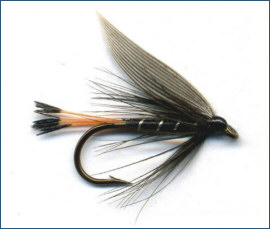
Early
Scottish Trout Flies
We do have some knowledge of the kind of
fishing flies in common use on Scottish rivers in earlier times
from the writings of WC Stewart, "the practical angler", who
promoted the use of simple spider patterns for the most part,
and very effective they were too in catching Scottish trout, I
suspect because of, rather than despite, their simplicity.
Examples of these simple flies, tied in the Stewart style, are
shown below. We also have to thank John
Reid, author of "Clyde Style Flies", for his
descriptions of the very particular style of fishing
flies used by fishermen on that great trout river,
the Clyde, including flies developed by Clyde
fishers specifically for their river, flies like the
Hen Blackie, Reid's Assassin and Cran Swallow, as
well as other traditional patterns, such as the
Greenwell's Glory, all dressed sparsely to imitate
as closely as possible the insects on the Clyde. |
|
|
Stewart Style Flies
|
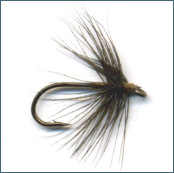 |
|
Stewart's Black Spider |
| |
|
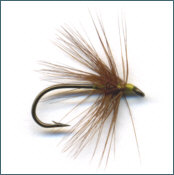 |
|
Stewart's Red Spider |
| |
|
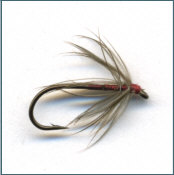 |
|
Stewart's Dun Spider |
| |
|
Clyde Style Flies
|
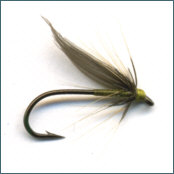 |
|
Clyde Style Greenwell's Glory |
| |
|
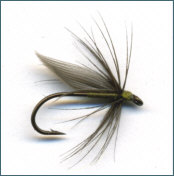 |
|
Clyde Style Hen Blackie |
| |
|
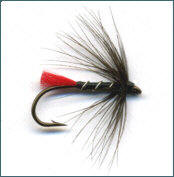 |
|
Clyde
Style Reid's Assassin |
| |
|
|
see also
Trout Flies |
|
See also
A Book of Flies.
This little book of flies, transcribed from a
meticulously kept hand-written notebook and published here for
the first time (August 2007), lists detailed dressings of the
many fly patterns used by the author in a lifetime of fly
fishing on the Clyde and other Scottish waters. In listing over
150 trout fly dressings, many of them little known beyond the
Clyde valley, Tom Forsyth has given us a valuable insight into
the kind of trout flies which were popular in Scotland
throughout the twentieth century. Of particular interest to the
modern trout fly fisherman and fly tyer will be the dressings of
the many "Clyde Style" flies, patterns unique to that great
Scottish trout and grayling fishing river. Also included is a
helpful Monthly Guide to Clyde Wet Flies, which lists the flies
appropriate for each month throughout the fishing season on the
River Clyde.
For most of us, though, the mention of Scottish
trout flies will conjure up pictures of the many beautiful loch fly
patterns, simple trout flies dressed from native fur and feather, their
origins perhaps long forgotten yet still as popular today as ever among
those who fish for trout on the lochs of Scotland.
Scottish Loch Flies
I list below just a small selection of
some of the most famous traditional
Scottish loch trout flies,
as fished on a cast of three or four, from a drifting boat or
from the loch shore. Most very old patterns, some of origin
unknown, they owe their survival to their reputation as reliable
takers of brown trout on lochs, large and small, the length and
breadth of Scotland. |
|
|
Traditional Scottish Loch
Trout Flies
Click on images to enlarge
Butcher
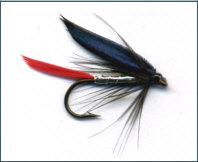 |
|
"The most deadly loch fly
ever invented, dressed with split wings well laid back, used on
the bob and made to trip across the waves, it is an exceedingly
reliable fly on every loch that I have fished. If winged in the
ordinary way it is quite a good tail fly and used by many in
this position with considerable effect". So said R. C. Bridgett.
Credit for the Butcher is accorded to Messrs Moon and Jewhurst.
Originally known as Moon's Fly, around 1838 the name changed to
"Butcher", the trade of its inventors. The name is apt in other
ways. |
Greenwell's Glory
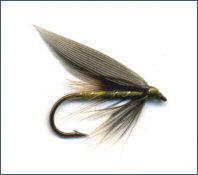 |
|
First dressed in 1854 on
the Tweed by James Wright, of Sprouston, for Canon William
Greenwell of Durham, the Greenwell's Glory has since become one
of the most well known and widely used of all British trout
flies. An excellent general olive representation.
Click to enlarge |
Peter Ross
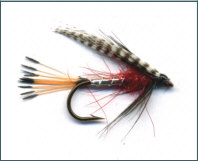 |
|
Dating from the turn of
the century and adapted from the teal and red by Peter Ross of
Killin on Loch Tay, this is one of the most popular loch flies
ever devised. A good tail fly.
Click to enlarge |
Black Pennell
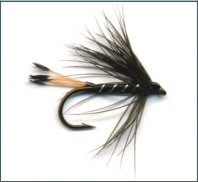 |
|
Devised in the nineteenth
century by H. Cholmondeley Pennell, the Black Pennell is
particularly popular in the remoter waters of the Highlands.
Commonly fished as a bob fly, it is especially good early in the
fishing season when black midges are hatching.
Click to enlarge |
Cinnamon and Gold
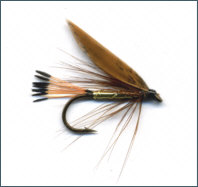 |
|
Probably deriving from the
age-old Cinnamon fly, the Cinnamon and Gold is particularly good
fished in the smaller sizes on the tail of a wet fly cast.
Click to enlarge |
Grouse and Green
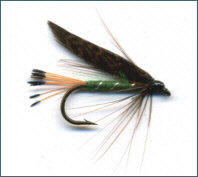 |
|
The Grouse and Green is one
of the best of the grouse winged trout fishing flies. A good
imitation of the sedge, or caddis fly.
Click to enlarge |
Blae and Black
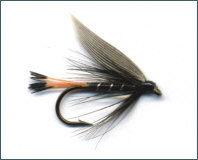 |
|
The date of this fly's
creation is difficult to pinpoint. Evolved from obscure Scottish
origins, it is best fished, like the Black Pennell, early in the
season as a top dropper, probably taken by the trout for a
hatching midge.
Click to enlarge |
Dunkeld
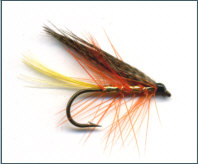 |
|
A simplified version of
the Dunkeld salmon fly, this is a good attractor pattern on both
lowland and highland lochs. One of the great loch flies, fished
on the tail of a cast as a small fish imitator, it is also
highly regarded as a sea trout fly.
Click to enlarge |
Mallard and Claret
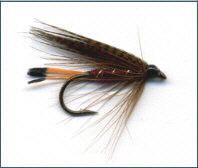 |
|
Accredited to William
Murdoch of Aberdeen, the Mallard and Claret has few peers as a
general loch fly. No fly box is complete without it, or its near
relative, the Grouse and Claret. A favourite of many trout
fishermen here in Scotland as a first dropper.
Click to enlarge |
Zulu
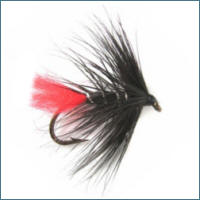 |
|
Once banned from
competitive angling on account of its killing properties, the
Black Zulu is best fished as a bob fly, tripped along the top of
the waves on dull windy days. Almost as good is the Blue Zulu, a
popular variant.
Click to enlarge |
Woodcock
and Yellow
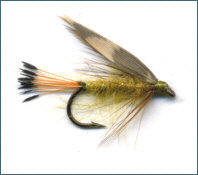 |
|
Probably the best of the
Woodcock series of trout flies. Like the Grouse and Green, a
good caddis representation used to good effect on summer
evenings. It also has a reputation among Scottish sea trout
fishers.
Click to enlarge |
Red Palmer
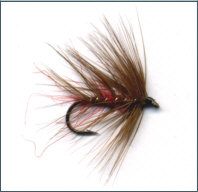 |
|
Not many flies kill as many
trout in the remote lochs of the Scottish Highlands as the Red
Palmer, other than perhaps the Black Zulu. Particularly good as
a bob fly in a big wave. With the addition of a red wool tail,
it becomes the Soldier Palmer.
see also
Trout Flies |
|
|
|
privacy |
|
|
|
Trout and Salmon Fishing |
|